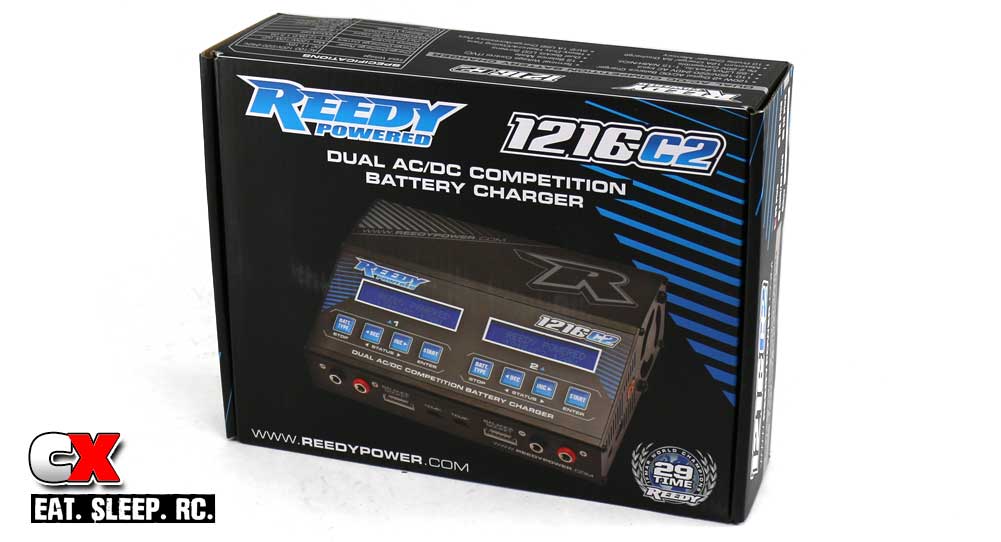
Dual-Port Powerhouse
Who remembers the old Reedy Quasar Pro chargers? Those were the hit back in the day – top-mounted LCD screen, 4 UI buttons, single charge port (NiCd or NiMh only) and a pair of big ol’ fans pumping air out the top. It was a great unit … I had two running at all times in my pit. One of the biggest downsides to having those was their size; it took up some valuable pit space, especially if you had more than one! Boy how times have changed! Take a look a Reedy’s newest countertop champion, the 1216-C2 AC/DC Competition Charger! This dual-port charger is set to take center stage with it’s gorgeous looks, intuitive menu system and microprocessor-controlled charging software. We pulled the 1216-C2 from the box, emptied out the accessories and pressed GO! Now lets talk about what we thought about it.
Specifics
Product: Reedy 1216-C2 Dual AC/DC Competition Balance Charger
Part Number: 27200
Cost: $174.99
Type: Charger/Discharger/Balancer
Input Voltage: AC 100-120V/220-240V, DC 11-18V
Charge Circuit Power: Channel A – 120W / Channel B – 120W
Charge Rate: Channel A – .1 to 12A / Channel B – .1 to 12A
Battery Type: NiCd, NiMh, LiPo, LiHV, LiFe, Li-Ion and PB Batteries
Cell Count: 1-15 NiCd/NiMh, 1-6 Lithium
Discharge Rate: .1 to 5A
Display: Dual, front facing backlit LCD screens
Additional Ports: Temperature Sensor Port, Micro USB Port, USB Port
What’s In The Box
Reedy has included everything you need to immediately start charging. You get the sleek-looking 1216-C2 charger, a power cord, two XH 2-6S balance boards, two charging leads with T-Plugs and a DC power cord. You also get a detailed manual that explains how to use the 1216-C2 as well as what all the internal functions do.
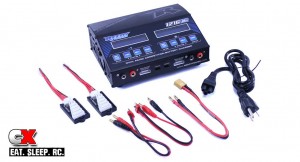
The Charger
The box that the 1216-C2 comes in is pretty sizeable, so when I opened the box I was a little confused, but in a good way. The 1216-C2 is actually quite a bit smaller than the footprint of the box itself; bad because I just expected something grandiose, but good because it’s actually a HUGE charger in a tiny package. Pulling it from the protective sleeve, I got my first in-person glimpse of it’s attractive black case covered in blue and grey graphics. It really is appealing, but enough of that – let’s do our walkaround and see what’s on the outside.
External
The case itself is all aluminum, screwed together on each end with stealthy black screws. The top face has the dual-backlit LCD screens, inset and flush with the case. Below them are the individual function buttons; four on each side. They control various charging, discharging and selection of variables within the 1216-C2. We’ll get to those in a second.
Below the function buttons on the front of the charger all the charge ports. Each side is identical and include a 4mm positive and negative banana plug port, 6-pin balance port and a temperature port. Everything has labels except for the 6-pin port – I’ll touch on that in a bit.
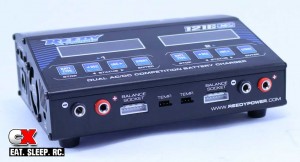
The right side of the 1216-C2 has a 5V USB port and PC Link. The 5V USB port can be used to charge USB-enabled items like your cell phone or GoPro. One thing I found odd was that the PC Link was not mentioned in the manual or on Reedy’s website at all, but I’m sure the boys over at Reedy have something up their sleeves that will use this port – maybe for a firmware update or a WiFi module. Also on this side is the DC plug, capable of delivering 11-18V of power to something, say, an additional charger. While this is something I’m going to try, I can’t say what kind of power I’ll be able to get from it especially if I have both ports humming away at the maximum 12A. To finish up the right side, a huge fan pulls the heat away from the internals.
The left side is similar to the right, housing a PC Link port and smaller fan unit. The AC power cord input is here as well as a VERY important AC Input Voltage switch. The switch can be swapped from 115 to 230V, depending on your location in the world. The manual states that ‘Failure to select the correct AC Input Voltage will result in permanent damage to the charger and the possibility of fire‘, so I would definitely make this the first stop before powering up the unit.
The back of the 1216-C2 is one long, finned heatsink. This is used to pull heat away from the electronics so, if you reach back and feel it getting a bit warm, don’t worry; the fans should kick in and keep everything nice and comfy.
Internal
Those of you that have dabbled with different chargers may find that the menu system in the Reedy 1216-C2 is quite familiar. If you said that it’s very Hitec-ish, you’d be right! The 1216-C2 uses the same software as Hitec’s upper line of chargers and I find that, well, AWESOME! I’ve been a huge fan of the Hitec menu system simply because it’s easy to understand and very intuitive, so I was so happy that Reedy simply stuck with what works and didn’t force me to learn something new (I’m old and established … don’t hate).
The four function buttons allow you to flip through the different menus to program the charger to your needs. The BATT TYPE button cycles through the different battery types as well as sending you over to the Battery Meter, Battery Profiles and System Setup. The DEC and INC buttons alter the variables of each setting, and the START button confirms your choices. The START button also sets the charger in motion once you have all the settings set. As I mentioned before, the menu system is great and, once you use it once or twice, you’ll be flying through it like it was second nature.
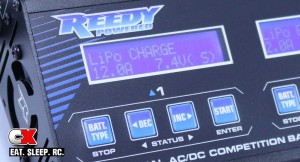
So we’ve covered the outside in some detail, let’s take a look under the aluminum cover at what makes this charger tick. The 1216-C2 uses a high-performance microprocessor and specialized software to control every facet of the charging system. Using both ports, it can charge, discharge or fast charge two LiPos, LiFes, NiCDs, NiMhs, LiLos or any combination of those by simply setting the ports to the correct battery specs. In fact, it can do that at a charge rate of up to 12A on each port! It also has a Balance and Storage function for the Lithium Ion batteries. The System Settings section allows you to modify parameters such as Capacity Cut-Off, Rest Time, Safety Time and Temperature.
The 1216-C2 allows the storage of 10 different battery profiles, allowing you to easily recall a certain profile to match the battery you’re using. This system allows you to set things like battery type, battery volts, charge rate, fast charge rate and storage rate. There is even a function called Terminal Voltage Control (TVC), a setting that allows you to tweak the charge voltage to pull maximum power from your cells. This is huge for stock racing, however the 1216-C2 does give a funny message when you activate it ‘TVC=Your Risk!’. Might want to be careful with this one!
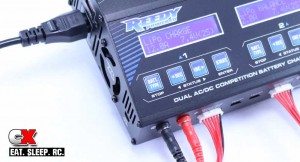
Performance
For this test, I fired up the Reedy 1216-C2 in the pit area at my house. I grabbed a pair of LiPos that had T-plugs (aka Deans plugs) and connected them to the charger. Well, sort of. My first pack connected fine; positive to positive, negative to negative and the XH plug to the XH balance board. The second battery, however, had a EH balance plug – uh, ya, that wasn’t going to work in the second XH balance board. Thankfully, the 1216-C2 uses a standard 6-pin balance board connector, so I was able to use one of Hitec’s Universal Balance Boards to charge the pack with the EH plug. One thing to note here; while you can use optional balance boards with Reedy’s 6-pin connector, the port is polarized (and unfortunately unlabeled as such). It is extremely important that the 6-pin plug you are using has the negative wire (black wire) all the way to the right.
After I resolved the balance board issue, I fired up both packs, charging at a low-key 6A. The 1216-C2 did a quick pre-charge check before quietly approving the charge.
The charge process was uneventful, save for a few exciting moments when the cooling fans kicked on. At the end of the charge, I cycled Port 1 over to the Battery Meter to take a look at the packs condition. This menu allows you to view a battery’s total voltage, the voltage of each cell as well as voltage of the highest and lowest cells. All my cells were well within the acceptable limits, and I can see how this function would really be helpful in keeping tabs on aging packs.
Conclusion
Reedy hit the nail on the head with its covert looks and magnificent menu system, making this charger an excellent addition for anyone looking for a high-end, dual-port AC/DC charger. The charger itself is fantastic – it’s a solid unit with lots of functionality. I would, however, suggest picking up a few different balance boards or one (or two) universal balance boards, especially if you already have an assortment of different Lithium batteries.
Features – 9.5
Menu System – 9.8
Fit and Finish – 9.5
Value – 9.5
Price – 9
Connect
Reedy, www.reedypower.com
 CompetitionX CompetitionX is the most up-to-date source for RC Car News, Reviews and Videos for Radio Control. We also have the most comprehensive Manual Database on the web.
CompetitionX CompetitionX is the most up-to-date source for RC Car News, Reviews and Videos for Radio Control. We also have the most comprehensive Manual Database on the web.











